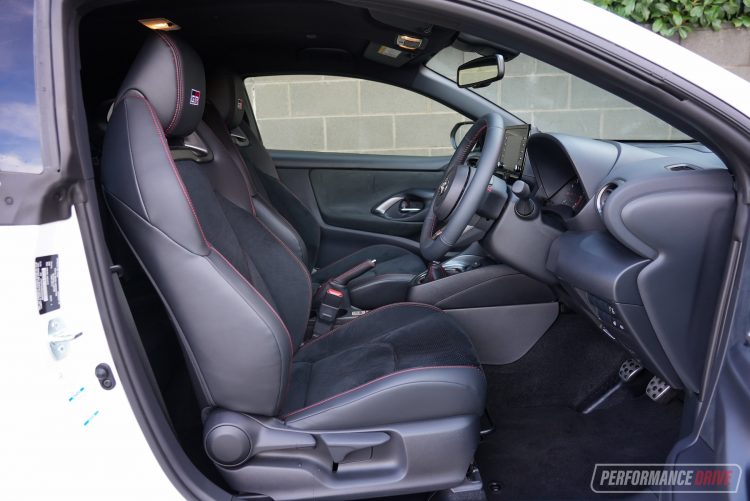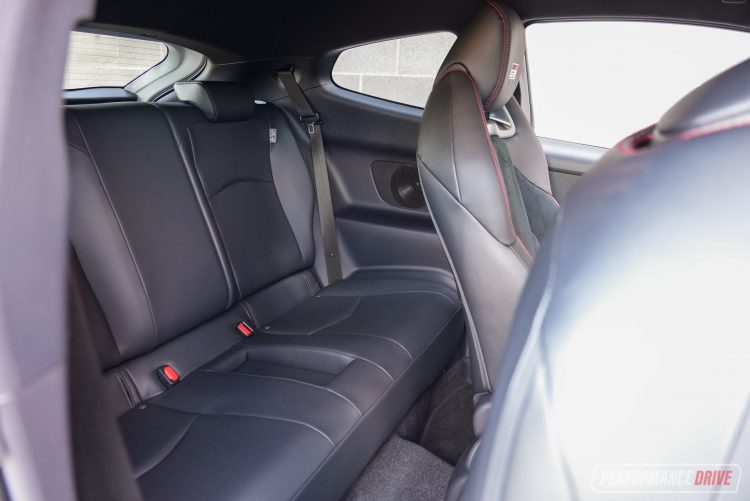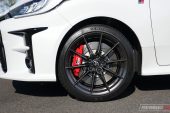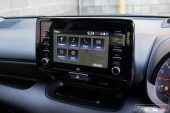Remember back in the 1980s when car manufacturers created wildly-winged over-boosted sports cars inspired by Group B rally cars? That’s what the 2021 Toyota GR Yaris Rallye is like, in a modern kind of way. Toyota has turned back time.

Toyota introduced the GR Yaris to support its endeavours in the World Rally Championship, with the Yaris WRC car. Yes, a hot hatch Corolla probably would have made more sense from a commercial point-of-view, as it is a more popular nameplate and a bigger market segment. However, there is a GR Corolla apparently on the way.
For now, the GR Yaris comes in two forms; the regular GR Yaris, as previously reviewed here, and the special Rallye edition. The latter comes with just enough enhanced gear to make it special. Toyota Australia hasn’t officially specified local allocation numbers but this is going to be a limited-build series – each example features its own build number plaque on the centre console, for example.
Prices are steep, but there is some justification in that the normal Yaris has become a lot more expensive due to increased technology and whatnot. The GR Yaris arguably involves more engineering than its main rivals too as it does feature all-wheel drive. Anyway, from $49,500 for the regular version and from $54,500 for this Rallye edition, it is very expensive, whatever way you look at it.
2021 Toyota GR Yaris Rallye – THE SPECS
[column width=”47%” padding=”6%”]Engine: 1.6-litre turbo three-cylinder
Output: 200kW@6500rpm / 370Nm@3000-4600rpm
Transmission: Six-speed manual
Drive type: All-wheel drive, Torsen LSD front & rear
Wheels: F & R: 18×8.0, 225/40
ANCAP: Not tested (regular Yaris 5 stars)
Tare weight: 1290kg
Power-to-weight: 6.45:1 (kg:kW)
Official fuel economy: 7.6L/100km
Economy during test: 9.1L/100km
Fuel capacity/Type: 50L/98 RON[/column] [column width=”47%” padding=”0″]Power efficiency: 26.31kW:L/100km
0-60km/h: 2.12 seconds*
0-100km/h: 4.94 seconds*
0-200km/h: 20.06 seconds*
60-110km/h: 3.53 seconds*
1/4 mile: 13.27 seconds at 171.0km/h*
Max acceleration: 1.036g
100-0km/h braking: 2.94 seconds at 37.07 metres*
Max deceleration: -1.179g
Decibel at idle: 51*
Peak decibel at 60-100km/h: 89*
Priced from: $54,500[/column][end_columns]
* Figures as tested by PerformanceDrive on the day. Factory claims may be different
2021 Toyota GR Yaris Rallye – THE PACKAGE
Let’s quickly talk about the additional gear and distinguishing features of the Rallye edition. The 1.6-litre turbo three-cylinder is untouched, producing a record-breaking 200kW at 6500rpm and 370Nm between 3000-4600rpm. This is all sent through an all-wheel drive system that Toyota calls GR-Four.
However, from there the Rallye version distributes the power via a Torsen limited-slip differential, at the front and rear. That’s crazy. Normally we’d see a limited-slip diff at the front for a hardcore hot hatch, even on AWD ones. But for this to have both, it means serious business. If you want to go rallying, for example, this is the sort of stuff you’d immediately upgrade to.

For the exterior the Rallye gets eye-catching red-painted brakes. They appear to be the same fundamental package though, with 356mm two-piece ventilated discs and four-piston calipers on the front, and 297mm ventilated discs and two-piston calipers on the back – the calipers are black on the regular model, with the same dimensions. Toyota does mention improved ducting for the front end, specific to the Rallye.
Surrounding the serious brake setup is a set of unique lightweight forged alloy wheels by BBS. They measure the same 18×8.0-inch size as the regular items, but they’re wrapped in 225/40 Michelin Pilot Sport 4 S tyres, over and above the standard Dunlop SP Sport Maxx 050 tyres – same size. So that’s lighter rims with grippier rubber.
Lastly, in terms of hardware, the Rallye gets a “circuit-tuned” GR sports suspension setup. This comprises of stiffer springs for the MacPherson struts and uprated stabiliser bars. No changes are made to the steering, and the same carbon fibre roof carries over, with aluminium for the doors, bonnet and hatch lid. In fact, the Rallye has the same kerb weight of 1280kg.

Forgetting the high sticker price for a moment, overall we think it’s fair to say the extra $5000 for all of this gear does represent decent value over the regular version. A good limited-slip diff in the aftermarket world would set you back anywhere from $1500-3000 (not fitted), multiplied by two. We did some shopping around and the Dunlop Sport Maxx tyres on the regular model cost around $189 each, while these Michelins cost around $225 (based on same size, from the same tyre outlet).
Very little changes are made to the interior. Actually, there are just two changes. The first is a switch from white contrast stitching to a racier red thread. Secondly, there’s a special build number plaque on the centre console/dash. Other than that you get the same hip-hugging sports seats in the front with suede inner sections for grip and leather-accented outer bits, along with similar suede trimming for the doors, sporty pedals, and a short-throw gear shifter and handbrake lever (yep, you can do proper hand-brakies).

We think Toyota has done a good job on the cabin features, layout, and design for the new Yaris. There are plenty of little nooks and cubby holes for random clutter that we all inevitably accumulate, and passenger space in the front is surprisingly good. The upright cabin orientation provides decent headroom, and visibility and ease of use are all very respectable.
That’s for a practical, city-living run-around car. This isn’t that car, though. This is a 50 grand hot hatch. And so some of the plastics can certainly seem a bit crude for this price point, although the features list is great. A 7.0-inch touch-screen (a bit small by today’s standards) comes with sat-nav, Android Auto and Apple CarPlay, digital radio, and there’s an eight-speaker JBL sound system. Head-up display is also standard, along with a plethora of active safety technologies.
What we’re missing here is a good driving position. It’s basically the same as the tall and somewhat dorky stance of the regular Yaris. Which is fine in that. But it is difficult to really settle in here. There is very little intimacy or cosiness.

Speaking of which, with the rear doors removed the back seat is obviously tighter than ever. We think it is okay for short trips and perfectly fine for the kids. The seat cushion is actually pretty big, so there is potential to find comfort back here so long as the front seats are not pushed right back and as long as you’re below average height.
The boot is also tiny. At 141 litres, there’s enough room for your race suit and a couple of helmets and that’s about it. You can fold down the rear seats, and they do fold completely flat, opening up 737L. Let’s face it though, this car was not born to pick up the shopping. It was born to be wild.
2021 Toyota GR Yaris Rallye – THE DRIVE
I’m not sure how many of you will relate to this, but I remember when HSV launched the Clubsport 185i back in the mid-1990s. It offered an unprecedented (at the time) one-hundred-and-eighty-five kilowatts, from an Aussie-made fuel injected 5.0 V8. Boy was that a lot. So much of my schooling was wasted due to daydreaming about what that level of performance would feel like. Well, Toyota has essentially pulverised those dreams, like a bully trampling on a freshly-cast sandcastle.
This little machine, with five fewer cylinders and less than a third of the combustion capacity, produces 15kW more power. Even with all of the rotating mass of a V8, the Yaris’s plucky three cylinders are just 30Nm shy of the 400Nm offered in the Clubsport. And it’s not like this is pressurised with insane boost. According to the on-board boost gauge it peaks at around 20psi. Mind you the compression ratio, at 10.5:1, is very high for forced induction.

Out on the road it is truly unbelievable. The off-beat three-banger sound seems rough and gutless, but then you look out the window and see the scenery blurring rapidly. The g-force is also really high. Again, it’s a contrast to what you’re hearing from the engine and what your mind is telling you to expect from a ‘puny 1.6’.
We did some acceleration runs again on a private road just to see if there was any difference with the regular GR model. We couldn’t reproduce the same 4.80-second time we achieved in the regular model across 0-100km/h, as hard as we tried. We suspect the heavier-duty diffs might add a tiny bit of extra load to the drivetrain, given that all four wheels would be driven more of the time, as opposed to just one front and one rear at times in the regular model. The best we found was 4.94 seconds. Obviously it’s a different car, different day, and, who knows, maybe different fuel quality in the tank at the time, but this is still an astonishingly quick time for a little hatch.

Anyway, it definitely feels just as quick. Mid-range pull is probably the most impressive part. It means that when you’re out in the mountains, or on a track, you can rely on third gear to keep charging through. As third gear is often the last gear ratio that offers a mechanical advantage (torque) before overdrive, we think this is where you can reel in on the competitors. 370Nm is extremely high for this class, too.
In saying that, it is lots of fun to row through the gears and enjoy high revs. This engine naturally becomes more balanced as the revs climb, so the noise goes from a fluttering gurgle to a nice roar. The gear shift action feels good, as does the clutch pedal. Toyota offers an iMT rev-matching function as well, which automatically blips the throttle on downshifts. For the more experienced driver, this function can be switched off so you can do it yourself (or not).
Do the new diffs transform the driving character? Yep, they certainly do. Obviously only under power. But it means you can get on the power, and more of if, nearer to each apex rather than drive it like a rally car, in a ‘slow-in, fast-out’ fashion. Now it seems to be more comfortable carrying speed and accelerating through the turn, with less understeer.

You can play around with the drive mode switch and that gives you either 60:40 (Normal mode), 30:70 (Sport), and 50:50 (Track), front-to-rear drive focus. Obviously Sport mode is the one we’d all pick. On the dirt or in the wet, however, we feel the Track mode with its 50:50 distribution is more suitable. In all honesty though, unless you’re pushing pretty hard you might not notice a difference between any of them. Especially if you’re just going for a leisurely drive in the country.
What we think really helps with handling is the switch to the Michelin tyres. We were not a fan of the Dunlops on the standard model. They seemed to be prone to tyre screeching and squealing, and braking performance was not all that impressive for the given technical recipe. Pulling up the 1280kg hatch is no concern. The big brakes provide repeatable stopping performance and offer excellent resistance to fade and pedal drop. But now there is a stronger initial bite, which instantly wipes off more speed. According to our Vbox tests, which were conducted on the same piece of tarmac to the other model, the Rallye can stop from 100km/h in 37.07 metres – the non-Rallye took 38.80m.
2021 Toyota GR Yaris Rallye – THE VIDEO
2021 Toyota GR Yaris Rallye – THE VERDICT
We adore this micro machine. We’re always excited when a car manufacturer goes a bit rogue and unprincipled, putting what seem like crazy ideas on paper and turning them into a production reality. As we said at the start, this is like a modern day Group B homologation model. It has the fat stance, mutant underpinnings, and wild powertrain. We’re not saying it is the overall best hot hatch in the world, but boy it’s hugely capable and lots of fun. And very, very interesting. We can’t wait to see what tuners end up doing with it, especially to liven up the exhaust note.
[column width=”47%” padding=”6%”]PROS:
– Amazing 1.6T 3CYL, monster torque feels
– LSDs front and rear really rip up the road
– Group B rally car looks
– Good fuel economy:performance ratio
[/column] [column width=”47%” padding=”0″]CONS:
– High price for its class
– Tiny boot
– Needs more exhaust sound[/column][end_columns]
As always, if you’re thinking about buying a new car don’t forget to click here to speak with our car buying specialists.






















